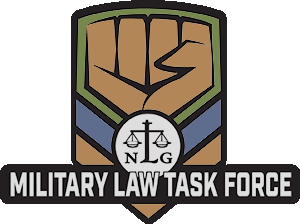By Kathy Gilberd
Note 1/25/19: Please see our update on this policy following the Supreme Court decision.
Note 11/30/18: This memo will be updated soon.
Updated: July 2017
Editor’s note, July 30, 2017: On July 26th, President Trump tweeted his decision that transgender personnel would no longer be able to serve in the military. Policy by tweet left people, including Pentagon officials, confused about what would happen and when. The next day, the 27th, the Chairman of the Joint Chiefs of Staff informed the services that no policy change will go into effect until Trump has issued a new policy to DoD, and DoD in turn issues a policy change. Until then, the JCS Chairman says, current regs are in effect. He added that all servicemembers would be treated with respect.
Editor’s note, July 5, 2017: This policy is undergoing regular transition within the US military and this page will be updated regularly to reflect the latest information available to us. The most recent update timestamp is below the article.
[download id=”3246″]In June, 2016, the Department of Defense (DoD) announced a change in military policy allowing transgender individuals to serve openly in the military. Under previous policy, they were prohibited from enlisting in the service and subject to administrative discharge if they began gender transition or simply announced their desire to do so. With Directive-Type Memorandum (DTM) 16-005, “Military Service of Transgender Service Members[1]” and DoD Instruction 1300.28, “In-Service Transition for Transgender Service Members[2].” DoD established a policy for retention, service and the expected enlistment of transgender individuals. While the new policy has significant limitations, and places much control in the hands of doctors and commanders, it represented a real victory for those who fought against the prior policy.
As of June 30, 2016, servicemembers may not be discharged, prevented from reenlisting, or otherwise denied continued service on the basis of their gender identity or their “expressed intent to transition genders,” according to the DTM. The Memorandum states that transgender personnel will be held to the same standards as others of their gender and that “[a] Service member whose ability to serve is adversely affected by a medical condition or medical treatment related to their gender identity should be treated, for purposes of separation and retention, in a manner consistent with a Service member whose ability to serve is similarly affected for reasons unrelated to gender identity or gender transition.” (Attachment, Para. 1.C)
Enlistment policy
Under the 2016 policy, enlistment and other accession standards were to be revised over a year’s period so that, no later than July 1 of 2017, DoD Instruction 6130.03, “Medical Standards for Appointment, Enlistment, or Induction in the Military Services,” would be changed to reflect new policies and procedures. Unfortunately, the military services formally requested that the enlistment policy be postponed, ostensibly to consider implementation issues. The Secretary of Defense accepted the recommendation and, on June 30, 2017, delayed implementation of the policy until January 1, 2018. It is not yet clear whether the standards for enlistment set out in the 2016 policy will remain the same, or whether they will be changed or the policy rescinded during the delay period.
Enlistment standards are framed in the negative in the DoD Memorandum. Under its provisions, a history of gender dysphoria will be disqualifying unless a licensed medical provider certifies that the applicant has been stable “without clinically significant distress or impairment in social, occupational, or other important areas of functioning” for a period of 18 months. A history of medical treatment associated with gender transition will be disqualifying unless a licensed medical provider certifies that (a) the applicant has finished all medical treatment associated with the transition; (b) the applicant has been stable in the preferred gender for 18 months; and (c) if receiving cross-sex hormone therapy after transition, the applicant has been stable on such hormones for 18 months. A history of sex reassignment or genital reconstructive surgery will be disqualifying unless a licensed medical provider certifies that 18 months has passed since the most recent surgery, no “functional limitations or complications persist,” and additional surgery is not required. (Attachment, Para. 2) The Service Secretaries may reduce or waive the 18 month periods in individual cases. The Memorandum also states that accession policy is to be reevaluated no later than 24 months from the date of the DTM to reflect changed understanding of medical practices, “ensure consistency with military readiness” and promote effectiveness in recruitment and retention policies.
Transitioning in the service
The DTM required DoD to establish policy by October 1, 2016, under which transgender Service members may transition gender while in the service. Also by that date, the Undersecretary of Defense for Personnel and Readiness was required to issue further guidance on provision of medical care and treatment of transgender Service members. Until then, requests for medical care and requests to transition were to be handled on a case-by-case basis “following the spirit and intent of this memorandum and DoDI 1300.28.”
The DTM states, in Paragraph 5, that discrimination based on gender identity is a form of sex discrimination, so that such discrimination would violate equal opportunity policy, and equal opportunity provisions would be used for discrimination complaints. DoD Directives on equal opportunity are to be revised to incorporate prohibition of such discrimination, and individual Service regulations must be updated to conform to those Directives.
The Memorandum also requires DoD to create training and educational materials designed for transgender personnel, commanders, medical professionals, and all Service members regarding the new policies. Training materials were to be provided to the Services by October 1, 2016, and the Services were required to develop implementing plans for education no later than November 1, 2016. A Commander’s Training Handbook, as well as medical guidance were to be available no later than October 1, 2016. Also by that date, DoD was to issue guidance for changing a member’s gender marker in the Defense Enrollment Eligibility Reporting System (DEERS), which will be used to demark members’ ‘official’ gender. In the interim, requests for gender transition from serving transgender members were to be handled on a case-by-case basis, again “following the spirit and intent of [the] memorandum and DoDI 1300.28.”
That DoD Instruction, which became effective on October 1, 2016, sets out a “construct” through which transgender personnel may transition gender in the service; specifies medical care for transgender members; creates procedures for changing DEERS gender markers; and implements other aspects of the DTM.
The Instruction states at Paragraph 1.2.c that “Service members with a diagnosis from a military medical provider indicating that gender transition is medically necessary, will be provided medical care and treatment for the diagnosed medical conditions. Recommendations of a military medical provider will address the severity of the Service member’s medical condition and the urgency of any proposed medical treatment. Medical advice to commanders will be provided in a manner consistent with processes used for other medical conditions that may limit the Service member’s performance of official duties.” Needless to say, this policy places considerable power in the hands of military doctors, and may create one of the areas where legal assistance to transgender personnel will be important.
Command decision-making on medical treatment
Subparagraph d of Paragraph 1.2 mandates that care and treatment will be provided in the same manner as any other medical treatment and that “[n]othing in this issuance will be construed to authorize a commander to deny medically necessary treatment to a Service member.” However, the Instruction notes that the commander is responsible for the collective morale, readiness, good order and discipline of his or her command, at the same time ensuring that personnel are treated with dignity and respect. Accordingly, when a commander receives a request that entails a period of non-availability for duty (as for medical treatment during gender transition), “the commander must consider the individual need associated with the request and the needs of the command, in making a decision on that request.” (Para. 3.1.f) Thus, while a commander may not deny treatment, he or she may significantly affect the timing of the treatment and the status of the Service member.
The Instruction sets out a number of actions that the services may authorize commanders to take in balancing individual needs against command needs, including, for example, adjusting the date when the member’s transition will commence, transferring the member to another command (including the inactive Individual Ready Reserve), adjusting local policies on berthing, etc., during gender transition, or referring personnel for a determination of fitness in the disability evaluation system. (Para. 3.2.d.(1)) The Instruction provides no specific guidance in these areas, though it is to be hoped that implementing regulations will limit the broad discretion given here. This, too, may be an area in which legal assistance for transgender personnel would be essential. The Instruction does require the Service Secretaries to establish Service Central Coordination Cells (SCCCs) to provide commanders with medical, legal and other advice and assistance on gender transition and service by transgender personnel, and to assist them in carrying out implementing regulations.
Transition requests
The Instruction repeats the existing requirement that active and reserve members notify military medical personnel and their commanders of significant health information, including whether they have or have had a condition that may limit their performance of duties. In this case, the notice to the command, presumably presented with the health care provider’s recommendation, triggers command action on the transition request. The member’s notification to the commander must “identify all medically necessary care and treatment [in the member’s] medical treatment plan and a projected schedule for such treatment, including an estimated date for a change in the member’s gender marker in DEERS.”
The commander must respond to a member’s notification/request to transition within 90 days. The response must be in writing and must include notice of any actions the commander intends to take in keeping with the Instruction and implementing regulations. But the commander may make changes to a previously approved approach to or an exception to the gender transition at any time prior to the change to DEERS, if he or she determines the modification is necessarily and appropriate. (Para. 3.3.) Implementing regulations are to include procedures allowing the member to request review by a senior officer of any subordinate commander’s decision regarding any request under the Instruction or any modification. (Para. 3.3.d)
DEERS and gender markers
Subpara. 1.2.g states that, when the medical provider determines that gender transition is complete, and at a time agreed to by the member and commander, DEERS gender markers will be changed and the member will be recognized in the preferred gender. Prior to the DEERS change, the member must meet all requirements of service of the initial gender; after the change, he or she must meet all requirements of service of the preferred gender, “and as to facilities subject to regulation by the military, will use those berthing, bathroom and shower facilities associated with the preferred gender.” (Para. 3.1.b) While the Instruction allows for some flexibility in individual cases, this sets a fairly rigid standard.
Para. 3.1.c discusses Real Life Experience, “the phase in the gender transition process during which the individual commences living socially in the gender role consistent with the preferred gender.” It notes that this must normally take place in off-duty status and away from the member’s place of duty prior to the DEERS marker change. Per Para. 3.1.d, prior to the DEERS change, the member must meet all uniform and grooming standards, PRT, and other military standards consistent with the existing gender marker; similarly, berthing and other facilities use must conform to the existing marker.
If military medical providers determine that continued care, such as hormone treatment, is needed after the DEERS change, the gender marker change does not preclude the treatment.
The Instruction requires the Services to establish policies for changing DEERS markers based on the medical provider’s determination that transition is complete, written approval from the commander issued in consultation with the member and production of documentation by the member showing gender change. That documentation must be a certified true copy of a State birth certificate showing the member’s preferred gender; a certified copy of a court order reflecting that gender; or a US passport reflecting that gender.
First term concerns
While not imposing a blanket prohibition on transition during a member’s first term of service, the Instruction notes the need for readiness and availability during the first term and allows commanders to take this “readiness model” into consideration in evaluating requests for transition. (Para. 3.5.a) Specific policies to carry this out are to be handled in the same manner as other medical conditions with a similar impact on ability to serve. Members are subject to entry level separation during initial training, (defined as the first 180 days of active service) if they have a medical condition that impairs ability to complete training. ROTC and service academy members are to be discharged if they have a medical condition that impairs ability to complete training or access into the military. The Instruction notes that ROTC and academy cases are each unique and should be evaluated on the basis of individual circumstances, but that members must be able to meet accession medical standards to qualify for graduation and appointment.
Reserves
Reservists are subject to the same provisions, with a few exceptions. All reserve members (except Selected Reserve full-time support personnel, who will follow the active-duty approval process) must submit to their command a medical evaluation including a medical treatment plan for transition. An evaluation by a civilian medical provider is subject to “review and approval” by a military provider. The commander and member are to address periods of unavailability “with a view to mitigating unsatisfactory participation.” The Instruction suggests rescheduling training, alternate training, and authorized absences as strategies.
Other policies
Members are subject to discharge for fraudulent or erroneous enlistment if there is found to be a “deliberate material misrepresentation, omission, or concealment of a fact, including a medical condition, that if known at the time of enlistment, induction, or entry into a period of military service, might have resulted in rejection.” (Para. 3.5.b.(3)
Section 3.6 of the Instruction warns about protection of personally identifiable information and unwarranted invasions of personal privacy, citing DoD Directive 5400.11[3]) and DoD Instruction 6025.18-R[4]. It states as well that commanders “may employ reasonable accommodations to respect the privacy interests of service members,” but provides no further detail.
Conclusion
While much remains to be filled in on the policies for transgender personnel in the military, the DTM and Instruction give a good overview. It is clear that the services will retain a great deal of control over gender transition and the service of transgender personnel. Despite the language prohibiting discrimination, this broad control may lead to official and unofficial discriminatory treatment. DoD’s decision to delay the enlistment/accession policy is more troubling, as it raises questions about the military’s and the administration’s commitment to the overall policy. Continued public pressure on DoD may be effective in retaining the in-service policies and initiating the enlistment policy, but this remains an uncertain time for transgender recruits and servicemembers.
Kathleen Gilberd is a legal worker in San Diego, California, and executive director of the Military Law Task Force.
[1] https://www.defense.gov/Portals/1/features/2016/0616_policy/DTM-16-005.pdf
[2] https://www.defense.gov/Portals/1/features/2016/0616_policy/DoD-Instruction-1300.28.pdf
[3] http://www.esd.whs.mil/Portals/54/Documents/DD/issuances/dodd/540011p.pdf
[4] http://www.esd.whs.mil/Portals/54/Documents/DD/issuances/dodi/602518p.pdf
Page last modified: [last-modified]



